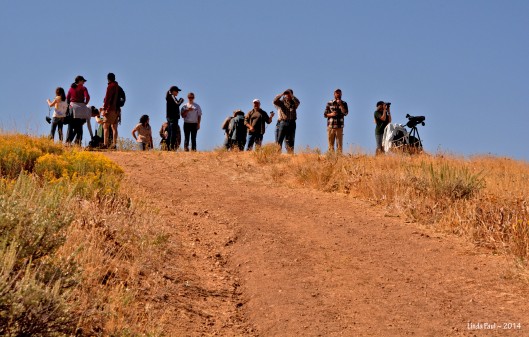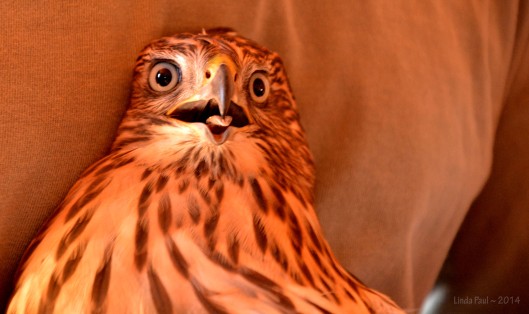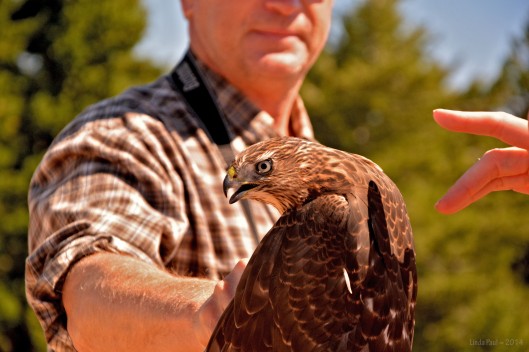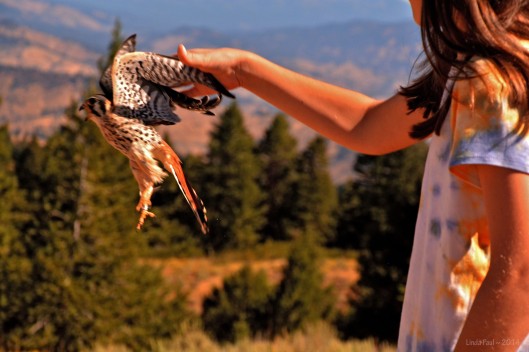My last post described songbird banding at the Intermountain Bird Observatory (IBO). After five hours of songbird trapping and banding, the nets were dropped and the crew headed for the top of the hill, shifting attention to the predators who begin gliding overhead as the mountain air warms and creates thermals for them to glide on.
Afternoons and evenings on Lucky Peak give over to hawk counts and diurnal raptor banding. Since 1993, IBO has tracked fall raptor migration in the Boise foothills. By adhering to standardized data collection methods of HawkWatch International, their observations can be integrated with counts from other locations to monitor continental population trends. While researchers glean the sky for the 18 diurnal (sleep at night, fly during the day) species that glide overhead, another group of researchers hides in a wooden blind constructed on a small knob on the shoulder of the mountain. From August through October, IBO snares and bands about 1000 raptors each year, gathering the same type of data about the predators as was collected for their prey, the songbirds: Species, sex, size and weight, condition of plumage, and possible presence of parasites.
While researchers glean the sky for the 18 diurnal (sleep at night, fly during the day) species that glide overhead, another group of researchers hides in a wooden blind constructed on a small knob on the shoulder of the mountain. From August through October, IBO snares and bands about 1000 raptors each year, gathering the same type of data about the predators as was collected for their prey, the songbirds: Species, sex, size and weight, condition of plumage, and possible presence of parasites.
If songbird trapping was unnerving, elements of raptor trapping verge on brutal. I guess it is one of those painful truths of life and of science. Some of us pay for the overall health and protection of the rest. In this case, pigeons and house sparrows—the low birds in the pecking order—are the bait used to lure the raptors into a variety of different nets that collapse and envelope a bird who has flown in close enough to investigate the menu. The trappers peering for endless hours from slots in the blind and puppeteering the traplines, are skilled and dedicated. The goal is no injured birds—predator or prey. The bait birds are rotated periodically, and in the rare event that a predator has actually settled on a sparrow or pigeon, the injured bird is quickly rescued, treated, and given some well-earned R&R. Admittedly, during the season, a few bait birds may die in the line of duty, but most recover from superficial wounds and are then released into the wild to live out the rest of their lives in retirement.

A dove, tethered under carefully rigged traps. From inside the blind trappers occasionally jerk the wires, causing the bait to flap and flutter, drawing attention to their compromised predicament.
Once in hand, the raptors are nothing short of magnificent in their haughty defiance.
How do you weigh a raptor? You stick it head-first into an elongated tin can, turn it upside down on the scale and voila! You have data. This also serves as a good means of transporting a raptor when necessary. Executive Director Gregory S. Kaltenecker is both knowledgeable and exceedingly proud of the work his organization does.
Executive Director Gregory S. Kaltenecker is both knowledgeable and exceedingly proud of the work his organization does.














Linda, a beautiful picture of a beautiful bird. I am going to get my daughter to check IBO out as she wants to study Wildlife Rehab in college and volunteered at the Carolina Raptor Center which rehabs birds and releases the ones they can. Thanks, BTG
LikeLike
How cool! If she needs a place to stay while visiting IBO, I’ve got an extra room!
LikeLike
Thanks Linda. She is wanting to attend a small college in the mountains here which has a wildlife rehab program. She attended a camp there for two straight summers. I was thinking of a visit for possible employment after she graduates. Plus, it will give me an excuse to come visit with her.
LikeLike
Invitation stands!
LikeLike
That was fascinating. Thanks. Great photos.
LikeLike
Always glad to know you enjoyed! Thanks for letting me know.
LikeLike
Hi Linda: What wonderful pics! Thx so much for sharing. I didn’t realize raptors migrated, as we have eagles and hawks hanging around here in Manitoba all year round — despite the horrid winters!
LikeLike
Thanks, Doreen. You know, now that I think of it, we have eagles in this area all year round too, I think. Here’s an article that discusses raptor migration: http://www.rpi-project.org/publications/TP-09.pdf I will be going to an owl banding event in a few weeks. I’ll ask about this in detail. It’s a great point.
LikeLike
Linda, I am formulating a trip out west to visit you and some of our blogging friends. Raye is in Portland and Barney is in California. It may also involve a tour of British Columbia. I also need to venture north to Minnesota as Toby and Hugh are up there. More to come. Suggestions welcome. BTG
LikeLike
Let’s move this to email, shall we? linda@rangewriter.biz I just got back from a road trip so I’m sort of swamped, but I’ll get back to you with some thoughts as soon as I can.
LikeLike